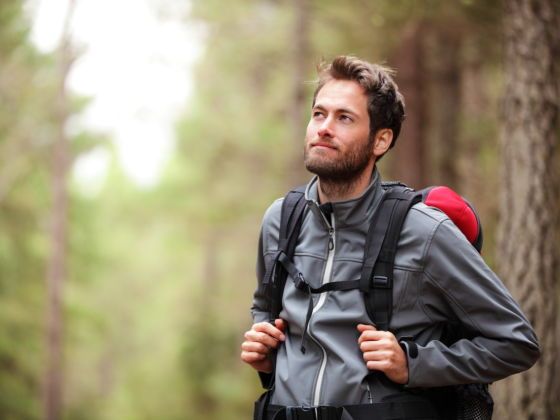This post was produced by Matador for our friends at REI, where it appeared in its original form.
1. Getting lost
It’s bound to happen: You’ll be distracted by a waterfall, snow-capped peak, or wildflower-filled meadow and miss your next turn. You’ll mistake one trail for another. You’ll go off-trail and head in the wrong direction. Whatever it is that causes you to lose your way, good backpackers know how to get unlost.
To get unlost: Stop and remain calm. Figure out where you are and then determine the safest route back on track. Fire up your GPS and get out your map and compass. Important note: You should know how to use your map and compass — they’re of little use if you don’t know how to orient, read, and employ them to determine your location. Buy the most detailed (and waterproof) topographic maps of the area you’ll be backpacking. If your map and compass skills are rusty or nonexistent, sign up for a class. While a huge help, never rely solely on the GPS — batteries die, signals drop, electronics malfunction.
2. Blisters
Preparation — breaking in your footwear, cleaning and drying your feet, regularly removing your shoes and socks throughout the trail day, treating hot spots early — goes a long way toward preventing blisters, but sometimes blisters happen regardless of preemptive measures.
So prepare yourself with a couple options of blister kits — second skin, blister pads, etc. There are all sorts of products on the market that will adhere to a blister or hot-spot zone to prevent further friction and irritation to the affected area. Whichever you choose to bring along, make sure they’ll remain attached to your hotspot even when your feet get hot, sweaty, and wet, which is to say, all the time.
3. Tummy aches
Too much hot sun, high-fat foods, or a plain-old bout of nervousness will lead to stomach and GI problems that can put a real damper on trail life. Bring along some anti-diarrhea and constipation medicine in your first-aid kit, but often you’re better off letting mild cases pass through you, so to speak.
Stay hydrated, pare back on the miles, and keep eating — bland, basic foods, preferably — until your digestive track returns to normal. If your GI problems persist or worsen, immediate evacuation to the nearest trailhead is your best option.
4. Wildlife encounters
Experiencing wildlife up-close in their natural habitat is one of the great joys of backpacking. Nothing quite punctuates a day in the backcountry like stumbling upon a mother bear playing with her cubs on a hillside, or watching a moose graze in a meadow. Finding and observing wildlife should be on every backpacker’s wish list, as long as we give these wild, free animals plenty of space and respect their habitats. Read up on the types of wildlife you’re likely to encounter in your region, and always know what to do in the rare event a wildlife encounter turns violent.
5. Route changes
Plan on changing the plan. Plan on something nearby — an alpine lake, unnamed peak, aspen grove — compelling you to change course and have a closer look. Plan on unexpected trail issues (see below) to force you to change your route. With that in mind, find alternative trails and trailheads that will accommodate possible changes. Scope those out on the map, Google Earth, or GPS beforehand so you always have an idea of how to might rework your route or change trails and trailheads entirely. While this isn’t always possible, expanding your understanding of the area you’re backpacking beyond just your intended route is best practice.
6. Trail closures
Always check ahead, but trail closures can and will happen with little to no notice. Late-season snow, mudslides, deadfall, and high water all collude to effectively close trails without notice. So even if you’ve done your due diligence by checking online, asking at the nearest ranger station, and quizzing fellow backpackers, be ready to encounter trails that are simply impassable. Have a plan B ready for trailheads, trails, and communicating with your loved ones in the event of an unannounced trail closure.
7. Weather events
The tired, yet true adage that there’s no such thing as bad weather, just inappropriate clothing, should be taken quite literally when backpacking. Expect rain, hail, and snow. Solid, expedition-worthy waterproofs, stove, and tent will solve most of your weather problems, save probably the most dangerous — lightning. Know and follow all recommended lightning procedures — here’s a great video to get started: https://youtu.be/PVSCD1mdzY0
And when in doubt from possible weather, plan for it or consider postponing your trip.
8. Gear failures
One week into my first backpacking trip, my external-frame (gosh, I feel old admitting that) backpack was primarily held together with duct tape and safety pins. My wife’s sleeping bag decided to evacuate its feather innards one night at 12,000 feet. All gear gives out eventually, but a few tips: Buy the best-quality gear you can afford, use it regularly, maintain it thoughtfully, and thoroughly review your gear before departing — check tent seams, boot soles and laces, backpack hip belts and harnesses, etc. Always carry a basic repair kit with duct tape, patches, needle and thread, as you very well may resort to Macgyvering your kit into working. Extending the life of your gear while in the backcountry is a badge of honor among we backpacker folk, and will almost always make a good fireside story: “There we were at 12,000 feet, wind howling, hail falling…covered in feathers.”
This post was produced by Matador for our friends at REI, where it appeared in its original form.
